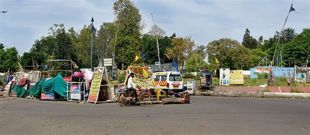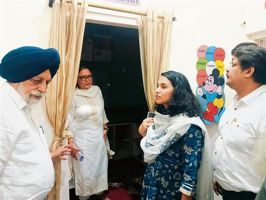
Clockwise from top right: Some rare photos of Bhagat Singh; martyr’s last letter from jail to his younger brother Kultar Singh; and the revolutionary’s name in his handwriting on a jail notebook. Photos courtesy: HarperCollins
Vishav Bharti
The RSS tried to appropriate him; the Congress tried to usurp his memory; as did the Khalistanis, but each attempt failed miserably. And that is because, before going to the gallows, the 23-year-old had penned down his thoughts on religion among many other things. That is why Bhagat Singh remains Bhagat Singh, an atheist, a socialist revolutionary who opposed communalism from the core of his heart. And here we have The Bhagat Singh Reader, another attempt to compile the writings of the martyr, this time edited by Chaman Lal, a former professor of JNU.
A question often asked is what stuff was the man made of — he, who had the courage to question Gandhi and the strength to smile from the gallows. To know the answer, there can't be a better way than going back to his own writings — his letters, telegrams; posters, notices, leaflets, court statements; essays, articles and sketches of revolutionaries. What makes this work special is that it has all of them.
The story of publishing of Bhagat Singh’s writings dates back to the late 1960s, when martyr's nephew Prof Jagmohan Singh and a college teacher Malwinder Jit Singh Waraich started publishing his writings in the Punjabi magazine, Quami Lehar. Later, the martyr's niece Virendra Sindhu published Letters and Documents in Hindi in 1974. Bhagat Singh's fellow traveller Shiv Verma (died 1997) took the work forward by publishing Selected Writings of Bhagat Singh in the late 1970s.
Since then, his writings have been available in many languages. Chaman Lal has been popularising these among the Hindi readers over the past several decades.
The current volume is mainly based on Prof Jagmohan Singh's Complete Writings of Bhagat Singh and His Comrades (2000), Bhagat Singh's Jail Notebook (1994) by Bhupender Hooja, Shiv Verma's Selected Writings of Bhagat Singh (1986) and Virendra Sindhu's My Revolutionary Comrades, a collection of sketches of martyrs written by Bhagat Singh for a special issue on capital punishment brought out by a magazine called Chand.
The book comprises letters by Bhagat Singh, from his first, written as an 11-year-old to his grandfather in Urdu, telling him about his performance in the examinations to letters written to his fellow traveller Sukhdev, where he discusses the concept of love and suicide. The 62 letters tells the entire tale, how a brilliant young lad evolves into a socialist thinker who had the courage to pen his thoughts even moments before being hanged.
Besides, Chaman Lal shares five letters from Bhagat Singh’s correspondence with the police and postal officials when his correspondence was being intercepted. However, the author chooses not to mention how these letters first came into public domain. These were first published by the Punjabi Tribune on September 27, 2017 and then, with some more details, in The Tribune on March 23, 2018.
Apart from the letters; posters, notices and leaflets published by the revolutionaries also give a reflection of the political discourses of the time and include his seminal essay, Why I am Atheist, and other writings. The court statements have already attained the status of a classic and were termed by Shiv Verma as one of the biggest contributions to the revolutionary movement.
Despite the writings that this collection comprises, a sizeable part of martyr's writings remains untraceable. Shiv Verma shocked everybody when he mentioned in the preface of a book that four manuscripts drafted by Bhagat Singh while he was in jail — The Ideal of Socialism, An Autobiography, History of Revolutionary Movement, At the Door of Death — were safely smuggled out of jail but were destroyed by the custodian for fear of police raids. In the introduction, Chaman Lal rightly laments about the indifferent attitude of custodians towards the documents of the martyr.
However, the silver lining is that a new crop of scholars in India and abroad has shown interest in the revolutionary movement. Among them is Aparna Vadik who was the first one to access most of the 160 files related to the Lahore Conspiracy Case that remained in oblivion for over eight decades.
Bhagat Singh Reader can be a good source book for English readers but some factual errors and the poor editing and proofreading mar it. In the intro, the editor refers Bristol Jail as Burail Jail (which came into existence in Chandigarh only after Independence). There are several other mistakes that a significant academic work can't afford to have.
Despite these editing lapses and some repetitions in introduction, this compilation needs to be celebrated as each word tells us why Bhagat Singh was not just a handsome brave man but a thinking rebel and a scholar revolutionary at just 23.



























